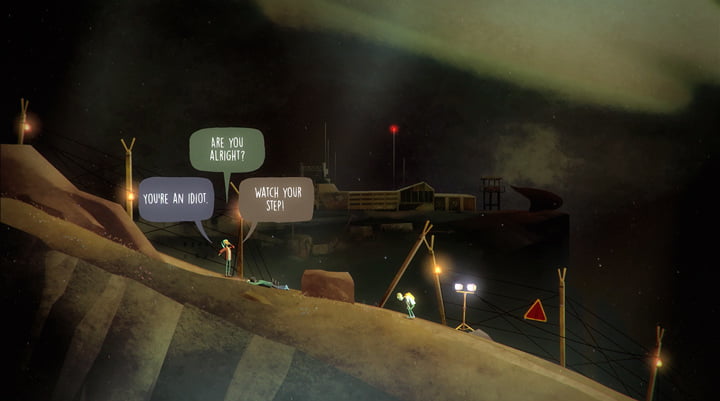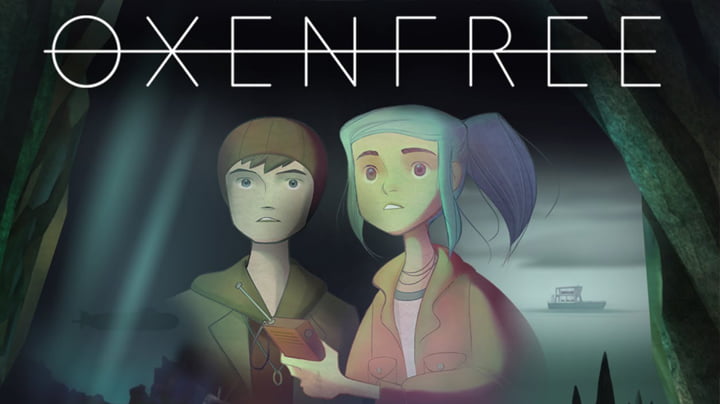In his GDC talk, ‘Building Game Mechanics to Elevate Narrative in Oxenfree’, Sean Krankel, discussed the methods Night School Studio used to combine gameplay and narrative in their hit 2016 game.
Night School Studio was established by cousins Sean Krankel and Adam Hines in 2014. To date the studio has released two titles, Oxenfree and the Amazon Original tie-in, Mr. Robot 1.51exfiltrati0n.ipa. When starting the studio they had the aim of making games focused on letting players push and pull at narrative in new and interesting ways.
“As we started the studio that was the thing we thought could focus in on and make something special,’ says Krankel. “But we knew we would have to do something really different to stand out.”
The starting point for Krankel and the team at Night School Studio was their approach to solving the problem of how most games treat gameplay and storytelling as separate entities.
“You would have a mechanics-driven encounter, then you’d move to some story telling. That story telling is either something that tells you what you are going to do next, or is there for emotional impact. Then you go back to the mechanics-driven encounter,” Krankel explains.
Although that approach often works well, Krankel knew that, as a small team, Night School Studio would have the opportunity to make a game where the mechanics were wholly dedicated to pushing the story.
“Every decision that we made in the game would focus on that,” says Krankel. “And that was the foundation of the studio, and for Oxenfree.”

The game’s story came together very quickly. Taking place at an overnight party, protagonist Alex and her step-brother unwittingly open a mysterious, ghostly rift. This inspirations for Oxenfree were very specific, perhaps even obvious. Coming of age adventures like The Goonies and Stand by Me, and spooky tales such as Poltergeist, are well-mined territory in movies but not necessarily in games.
“We were falling in love with this story, maybe a little bit too much, but because we were loving where it was headed we decided to let it drive all our mechanics,” Krankel says. “Historically, we like to find a set of mechanics, and then build the game around that set of mechanics, and then build the narrative to support those mechanics. And we were a little nervous about the change in approach.”
The What vs The Why
A guiding principle in the development of Oxenfree was the ‘The What vs The Why’. What is the player doing and why is the player doing it?
In film answering these questions is usually easy. The What is the plot of the film, its sequence of events, and the Why is the story, how that series of events happens.
“Games are primarily a What medium, because they’re interactive. So the the What is a set of mechanics and encounters and Why still remains the story.” Krankel explains.
“We were finding ourselves in this dilemma of how to make this story-focused game, with no overt challenge, be mechanically satisfying. What mechanic would best represent the story that we were developing, and how could we escalate that over the course of the game?”
The answer was to base the game around the theme of communication. To illustrate the approach, Krankel showed examples of lead character Alex’s What and Why at points before and after the rift is opened at the end of the first act.
Alex’s Why
Before
- Overcoming awkwardness
- Defining her/yourself
After
- Forging bonds
- Coming to terms with her brother’s death
- Bringing peace to the ghostly inhabitants
Alex’s What
Before
- Exploration
- Verbal communication
After
- Exploration
- Verbal communication
- Radio communication
- Puzzles
- Dialog choices
“If you break that down to the What, it’s actually super-basic. It’s essentially exploring and communicating, so instead of escalating challenges to what you are doing, we would escalate the stakes of why you do it through the story,” says Krankel.
To make environmental exploration conducive to storytelling some ground rules were laid. Firstly, movement had to be contiguous.
“We never wanted there to be a cut-scene, so there’s never a cut scene on the game,” says Krankel. “It was crucial to us to say we’re never going to take control away from the player at any time.”
Secondly, a decision was made to make the game a big screen, lean-back experience, and not a point and click adventure.
“You can play it that way but we wanted to make sure the foundation of the game was still something you could play with a controller and feel really natural and fluid.”
The most important game design choices related to communication. The act of choosing dialog had to feel like an ability, not a menu choice.
“It had to feel like an ability, an extension of you. That meant in the writing process we had to think of a wide array of options,” says Krankel.
The writing process had to ensure that choices didn’t fall into the age-old trap of being either good or bad, light or dark. They had to reflect what the player would actually want to say in any given scenario.

Another important design choice was that Alex never talks unless the player makes her. In fact, the game can be played without Alex ever speaking a word – an achievement feat– as other NPCs will pick up the slack.
“There’s never a moment in the game where Alex will say something unless you decide to initiate it,” Krankel says. “It was really crucial in making it feel more like an ability and less like a set a of menu choices.“
The game’s visual approach was also important in supporting these design choices. Long camera shots were used to show the player, NPCs, the environment, as well as all the dialogue bubbles used to communicate.
“The talk bubbles are positioned the way that they are because we didn’t want players to have to look up or down, or at sub-titles,” says Krankel.
“We wanted them to feel as connected to Alex as possible, so while you’re playing and deciding what to say, your eyes aren’t moving around the screen.”
The conclusion of Oxenfree went through multiple revisions as the the studio attempted to create a mechanically satisfying ending for the game.
“We were late in the game and we were trying to sort out a conclusion and we had these elaborate puzzles and were ham-fisting new mechanics,”
To solve the problem Krankel and the team returned to the game’s core communication mechanics and built the conclusion around them, raising the stakes though story rather than puzzles, and found the ending the game truly deserved.
“All these decisions came together to make a game that our team is super proud of. We’re beyond grateful to have a community of players that have connected with Alex both inside and outside of the game,” says Krankel.
“And we’re pretty sure that the community has connected with her because they can feel that when we were making Oxenfree we were always more worried about why Alex would do something, why she would make a decision, why she would put herself in harms way.”






